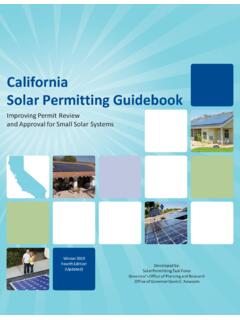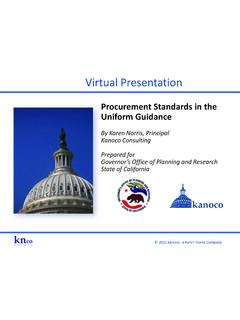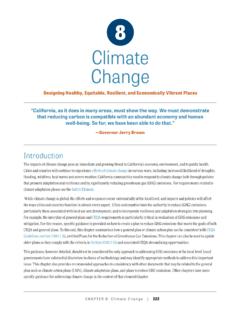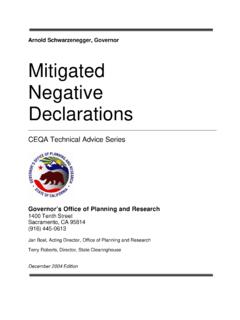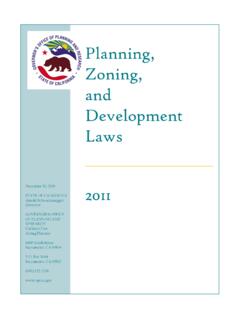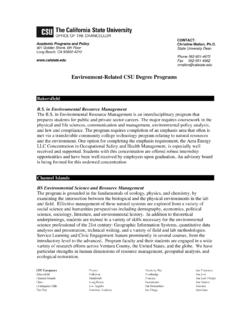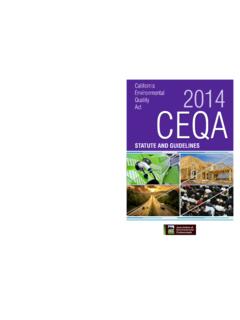Transcription of ENVIRONMENTAL JUSTICE IN CALIFORNIA STATE …
1 ENVIRONMENTAL JUSTICE IN. CALIFORNIA STATE GOVERNMENT. October 2003. Office of Governor Gray Davis Planning and Research Gray Davis, Governor Governor's Office of Planning and Research Tal Finney, Interim Director 1400 Tenth Street Sacramento, CA 95814. Sandra Salazar-Thompson, Director of the ENVIRONMENTAL JUSTICE Project Bonnie Chiu, Assistant Director, ENVIRONMENTAL JUSTICE Project (916) 322-3932, main (916) 323-2675, fax ENVIRONMENTAL JUSTICE IN CALIFORNIA STATE GOVERNMENT. TABLE OF CONTENTS. PREFACE i CHAPTER 1: CONTEXT & HISTORY OF ENVIRONMENTAL JUSTICE 1. CHAPTER 2: CALIFORNIA 'S ENVIRONMENTAL JUSTICE FRAMEWORK 3.
2 CHAPTER 3: OPR'S ENVIRONMENT JUSTICE PROJECT 5. CHAPTER 4: STATE AGENCY ENVIRONMENTAL JUSTICE ACTIVITIES 7. CHAPTER 5: ENVIRONMENTAL JUSTICE AND SOCIAL EQUITY 10. CHAPTER 6: ENVIRONMENTAL JUSTICE FINDINGS, GOALS, AND POLICIES 14. APPENDIX A: EJ STATE AGENCY COORDINATORS. APPENDIX B: CAL/EPA INTERAGENCY WORKING GROUP RESOLUTION. ADOPTING EJ RECOMMENDATIONS. APPENDIX C: MONTHLY EJ WORKSHOP INVITATION. APPENDIX D: EJ RESOURCE LIST. APPENDIX E: SENATE BILL 115 (SOLIS, STATUTES OF 1999). APPENDIX F: STATE EJ POLICIES. ENDNOTES 81. ENVIRONMENTAL JUSTICE IN CALIFORNIA STATE GOVERNMENT.
3 PREFACE. In CALIFORNIA , we have spent over ENVIRONMENTAL JUSTICE (EJ) means the fair a century and billions of dollars treatment of people of all races, cultures and to preserve and protect the income with respect to development, adoption and environment for current and implementation of ENVIRONMENTAL laws, regulations future generations. The EJ. movement asks us to put real and policies.. people in that environment, Government Code (c). particularly the most vulnerable populations such as ethnic minorities, low-income persons, the young and the elderly. In a nutshell, EJ can be said to be the vision and process of creating socially just, sustainable human and ecological systems, where all participate fully in decisions affecting their lives.
4 The Governor's Office of Planning & Research (OPR) assists the Governor and the Administration in land use planning, research, liaison with local government, small business advocacy, rural policy, and various interagency taskforces. 1999 legislation defined EJ in CALIFORNIA law and also established OPR as the coordinating agency in STATE government for ENVIRONMENTAL JUSTICE (EJ) efforts. The placement of the central EJ program within OPR. demonstrates the Legislature's understanding that EJ efforts require coordination at the highest level of STATE government. Indeed, CALIFORNIA is the only STATE that has placed its EJ effort within the Chief Executive's Office.
5 The legislation establishing OPR as the coordinating agency in STATE government for ENVIRONMENTAL JUSTICE programs ( CALIFORNIA Government Code ) directs the OPR. director to consult with STATE agencies and interested members of the public and private sectors in this STATE , coordinate its efforts and share information regarding EJ programs with federal agencies, and review and evaluate any information from federal agencies that is obtained as a result of their respective regulatory activities. This policy report is intended to provide a brief history of EJ, report on the status of OPR's efforts, and provide an outline of EJ findings, goals and policies for future EJ efforts within STATE government.
6 Much work remains to ensure that the most vulnerable of Californians, including people of color and low-income persons, are treated with dignity and respect regarding ENVIRONMENTAL decisions. OPR views its work thus far as a modest, although significant beginning. i CHAPTER 1: CONTEXT & HISTORY OF ENVIRONMENTAL JUSTICE . Community organizations and EJ activists spearheaded the ENVIRONMENTAL JUSTICE movement across the country. In essence, the EJ movement was the grass-roots response to both public and private sector actions which oftentimes, either intentionally or unintentionally, targeted communities of color and low income populations and/or excluded such communities from the processes by which ENVIRONMENTAL decisions were made.
7 Historically, many EJ communities have raised issues related to the unequal enforcement of ENVIRONMENTAL , civil rights, and public laws; differential exposure of minority and low-income populations to health risks in the home, school, neighborhood, and workplace; and, faulty assumptions by government agencies and private entities in calculating and assessing risks to minority and low-income populations. In addition, discriminatory zoning and land use practices and exclusionary policies and practices have limited the effective participation by minority and low-income residents in governmental processes and have fueled the EJ movement.
8 Many say that the story of modern EJ movement began in the early 1980's in Warren County, North Carolina. There, residents fought the location of a toxic waste landfill in a small town where authorities wanted to bury 32,000 cubic yards of soil contaminated with polychlorinated biphenyl (PCB). The town of Afton was both predominantly African-American and low income. Although the landfill was eventually constructed, national attention was brought to the situation where race, poverty, and inequity seemed to Closer to home, in the early 1990's, national attention was focused on a small community in Kings County, CALIFORNIA .
9 Kettleman City hosts the largest toxic waste dump west of Alabama and in 1988, the more than 95% Latino farmworker community was faced with the prospect of the creation of another major toxic waste incinerator in their area. Despite the largely Spanish-speaking community, the ENVIRONMENTAL Impact Report of nearly 1,000 pages, initially, was not translated into Spanish, nor were adequate translation services provided at the public hearings. In a subsequent lawsuit, the judge ruled that the Kettleman City residents were effectively precluded from meaningful involvement in the CALIFORNIA ENVIRONMENTAL Quality Act (CEQA) review process.
10 By September 1993, the project proponent, Chem Waste, withdrew its proposal for the toxic waste incinerator. The City of Bell Gardens, CALIFORNIA (in southern Los Angeles County) also garnered national attention in the 1990's. An increased risk for cancer, miscarriage, and catastrophic illness brought focus on two chrome plating plants in particular, but also the several factories and plants located in the largely Hispanic, lower income community. The Suva Elementary and Intermediate Schools are located next to one of the metal plating plants. The high pollution concerns caught the attention of CALIFORNIA lawmakers who sought to reform health standards to levels that protect children and not just adults.

